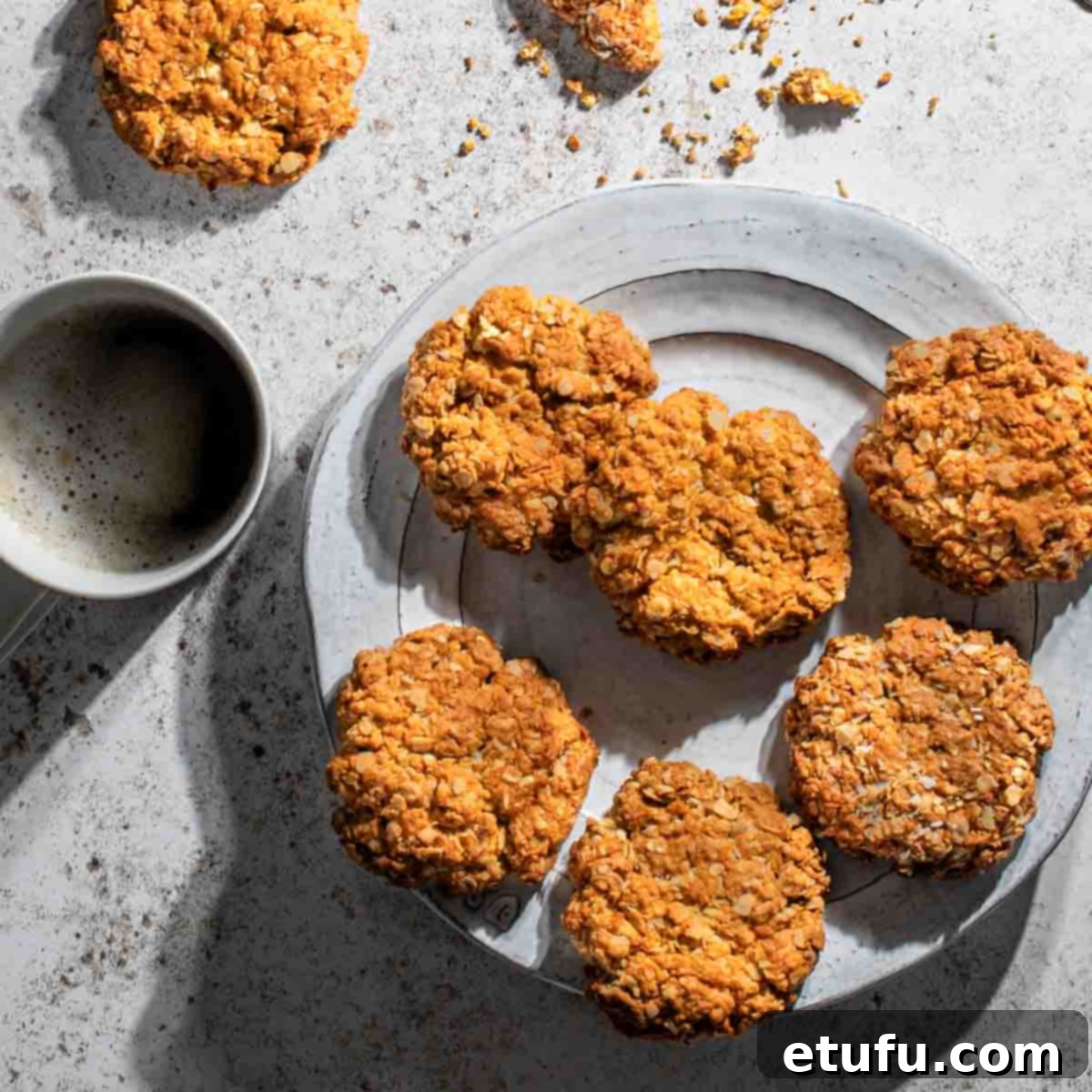Craving a delightful treat that’s both deeply satisfying and incredibly easy to make? Look no further than these irresistible **chewy coconut biscuits**. Far from your typical light and airy coconut macaroons, this recipe delivers a wonderfully substantial biscuit, generously packed with the comforting goodness of oats, rich desiccated coconut, dark brown sugar, and the unmistakable golden touch of golden syrup.
Imagine the perfect fusion of an Australian Anzac biscuit’s wholesome chewiness and a British flapjack’s syrupy richness – that’s precisely what awaits you. With just a handful of straightforward ingredients, you can have a batch of these glorious **homemade coconut cookies** ready to enjoy with your afternoon tea or as a hearty, on-the-go snack in virtually no time.
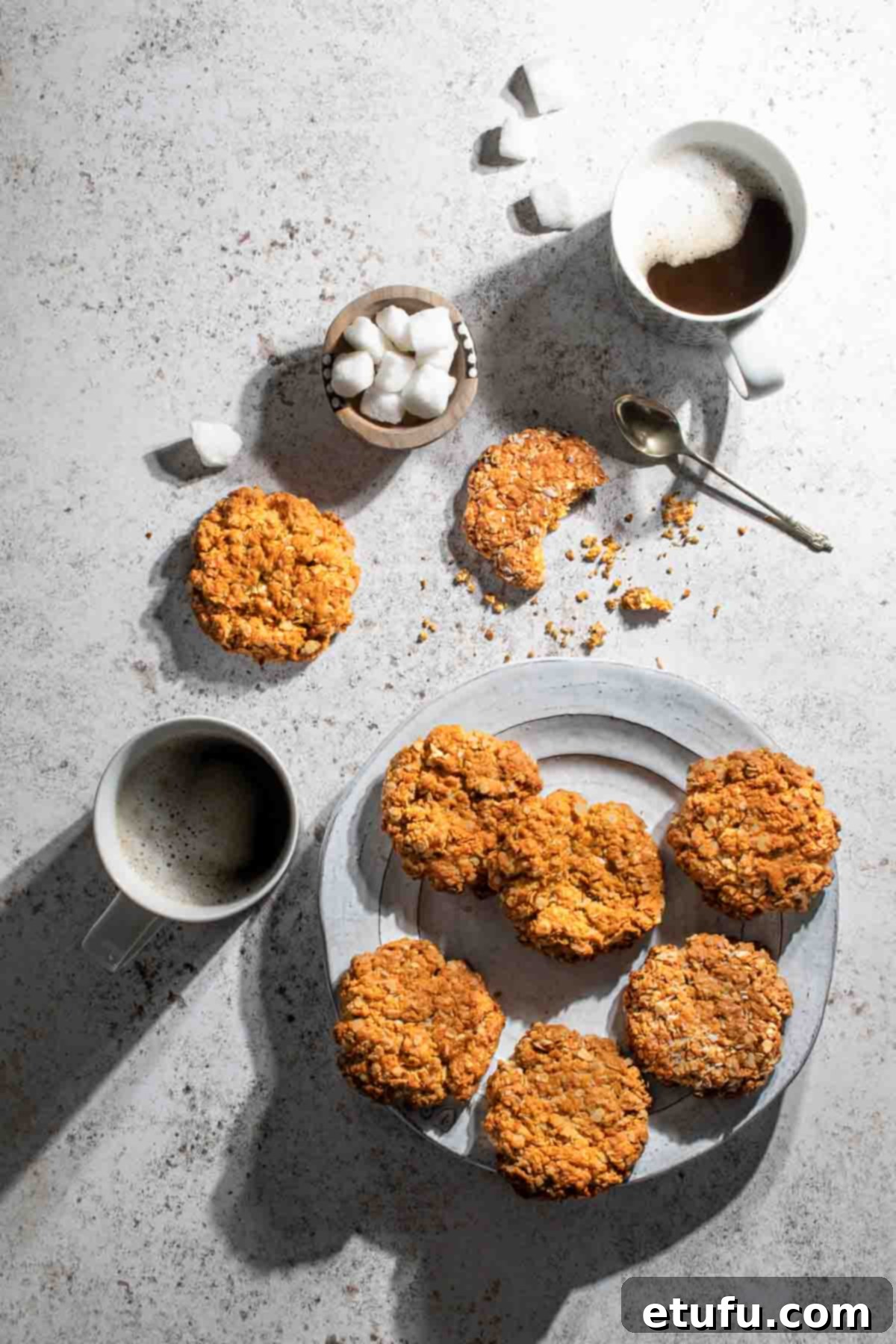
Why You’ll Adore These Syrupy, Chewy Coconut Biscuits
This **simple coconut biscuit recipe** isn’t just another sweet treat; it’s a celebration of texture, flavor, and effortless baking. Here’s what makes these golden delights an absolute must-try:
- Effortless Baking Experience: Perfect for bakers of all skill levels, from absolute beginners to seasoned pros. This recipe requires no complex techniques, elaborate equipment like a stand mixer or electric hand mixer, nor even a cookie cutter. Just simple mixing and shaping, making it a joy to prepare.
- Unforgettable Chewy & Moist Texture: The magical combination of golden syrup and dark brown sugar isn’t just for sweetness; it’s the secret to their incredibly rich, moist, and delightfully chewy texture that melts in your mouth with every bite.
- Hearty and Filling: The generous addition of rolled oats transforms these from a light bite into a truly substantial and satisfying biscuit. They’re perfect for curbing hunger pangs or providing a delicious energy boost.
- A British Flapjack Twist: For those who cherish the comforting chew of a traditional British flapjack, these biscuits offer a familiar yet exciting twist. They embody the same wholesome appeal but in a convenient, cookie-like form.
- Naturally Eggless Coconut Cookies: Ideal for those with egg allergies or dietary preferences, this recipe delivers fantastic results without a single egg.
- Perfect for Gifting: Baked with love, a beautiful tin of these “Oaties” makes a thoughtful and much-appreciated gift for any coconut enthusiast or anyone who loves a good homemade treat.
Key Ingredients for the Best Coconut Biscuits: Notes and Substitutions
Each ingredient plays a vital role in crafting the signature flavor and texture of these **golden syrup coconut cookies**. Understanding them will help you achieve perfect results every time.
Rolled Oats (Oatmeal)
Rolled oats are the backbone of these substantial biscuits, providing their wholesome texture and satisfying chewiness. You can find rolled oats (often simply labeled as “oatmeal” in many supermarkets) in various textures. Feel free to use your preferred type, whether it’s fine-milled for a slightly smoother bite or coarser for a more rustic feel. Avoid instant oats, as they can alter the texture of the final biscuit.
Dark Brown Sugar
This isn’t just any sugar; dark brown sugar is essential for its deep, molasses-rich flavor and its significant contribution to the biscuit’s moistness and chewiness. The molasses gives these cookies a wonderful caramel-like depth that perfectly complements the coconut and oats. While dark brown sugar is highly recommended for its unique profile, you can substitute it with light brown sugar in a pinch, though it may result in a slightly less intense caramel flavor and a marginally less moist biscuit.
Desiccated Coconut
Desiccated coconut refers to finely shredded, dried coconut flesh, a common staple in the baking aisle. It’s crucial to use desiccated coconut for this recipe, not coconut flakes, which are larger and will create a different texture. The fine shred of desiccated coconut integrates beautifully into the dough, distributing its tropical flavor evenly throughout each biscuit.
Golden Syrup
Golden syrup is a thick, amber-colored inverted sugar syrup, renowned for its distinct buttery, caramel-like flavor and glossy sheen. It’s a cornerstone ingredient in many British and Australian baked goods, including these **chewy oat biscuits**. While once harder to find in some regions, it’s now widely available in most major supermarkets, particularly in the international or baking sections. Lyle’s Golden Syrup is the most iconic and popular brand. For precision and ease, remember that four tablespoons of golden syrup equate to approximately 80 grams, making weighing a less sticky and more accurate method than measuring by spoon.
How to Make Your Own Easy Coconut Biscuits: Step-by-Step
Follow these straightforward steps to create a batch of homemade coconut biscuits that are sure to become a family favorite.
- Prepare Your Workspace: Begin by preheating your oven to 170℃ (338℉ / Gas Mark 3). This ensures your oven is perfectly warmed for even baking. Line two large baking sheets with parchment paper or silicone mats; this crucial step prevents sticking and ensures your biscuits can be easily removed once baked.
- Combine Dry Ingredients: In a spacious mixing bowl, combine the rolled oats, all-purpose flour, dark brown sugar, and desiccated coconut. Give these a good stir until they are well mixed.

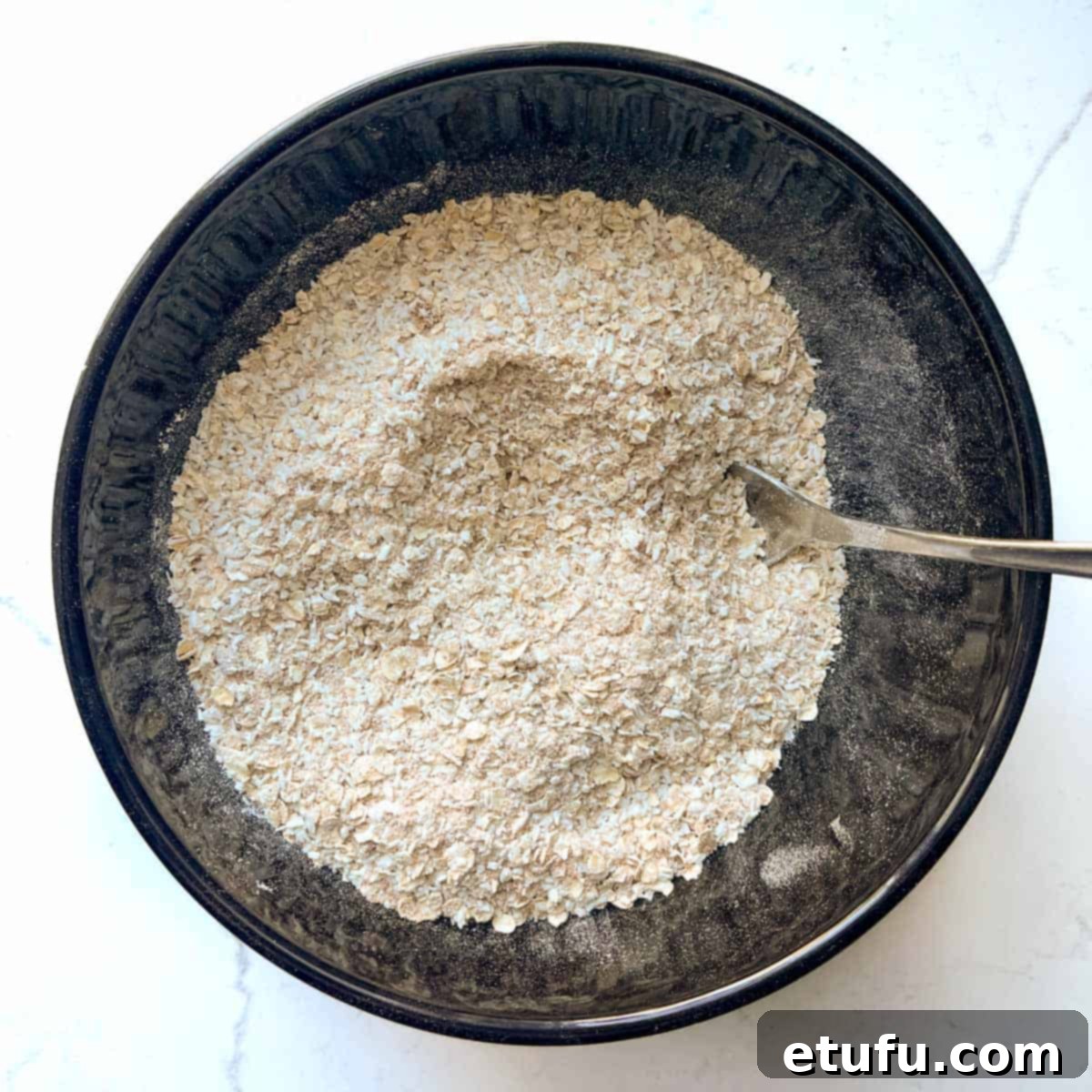
Dark brown sugar can sometimes form stubborn lumps. Take a moment to break apart any visible clumps with your fingers or the back of a spoon, ensuring an even distribution of sweetness and moisture throughout the dough.
- Melt Wet Ingredients: In a small saucepan, combine the unsalted butter, golden syrup, and vanilla extract. Place the saucepan over a gentle heat and stir continuously until all the ingredients have melted together into a smooth, fragrant liquid. Be careful not to let it boil.
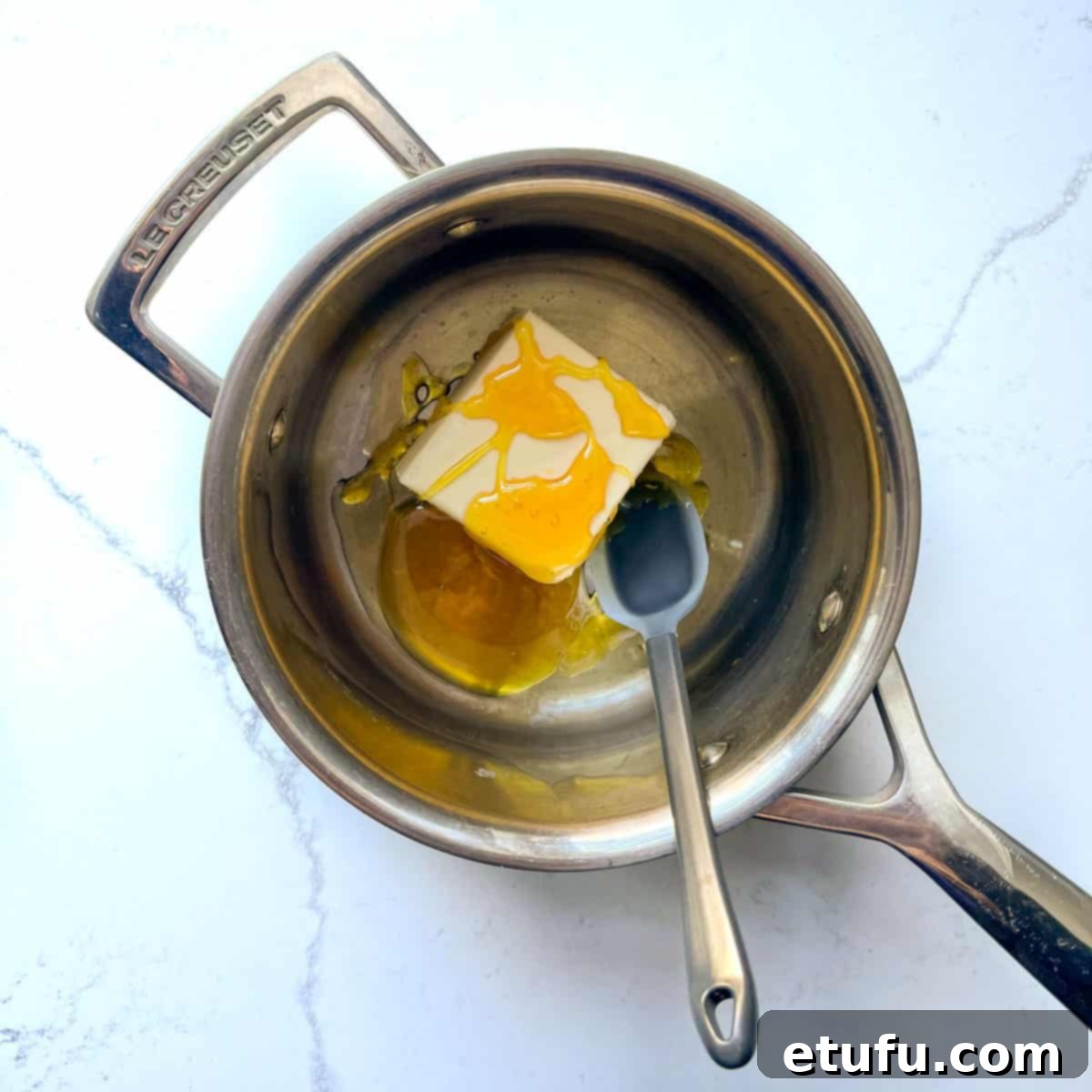
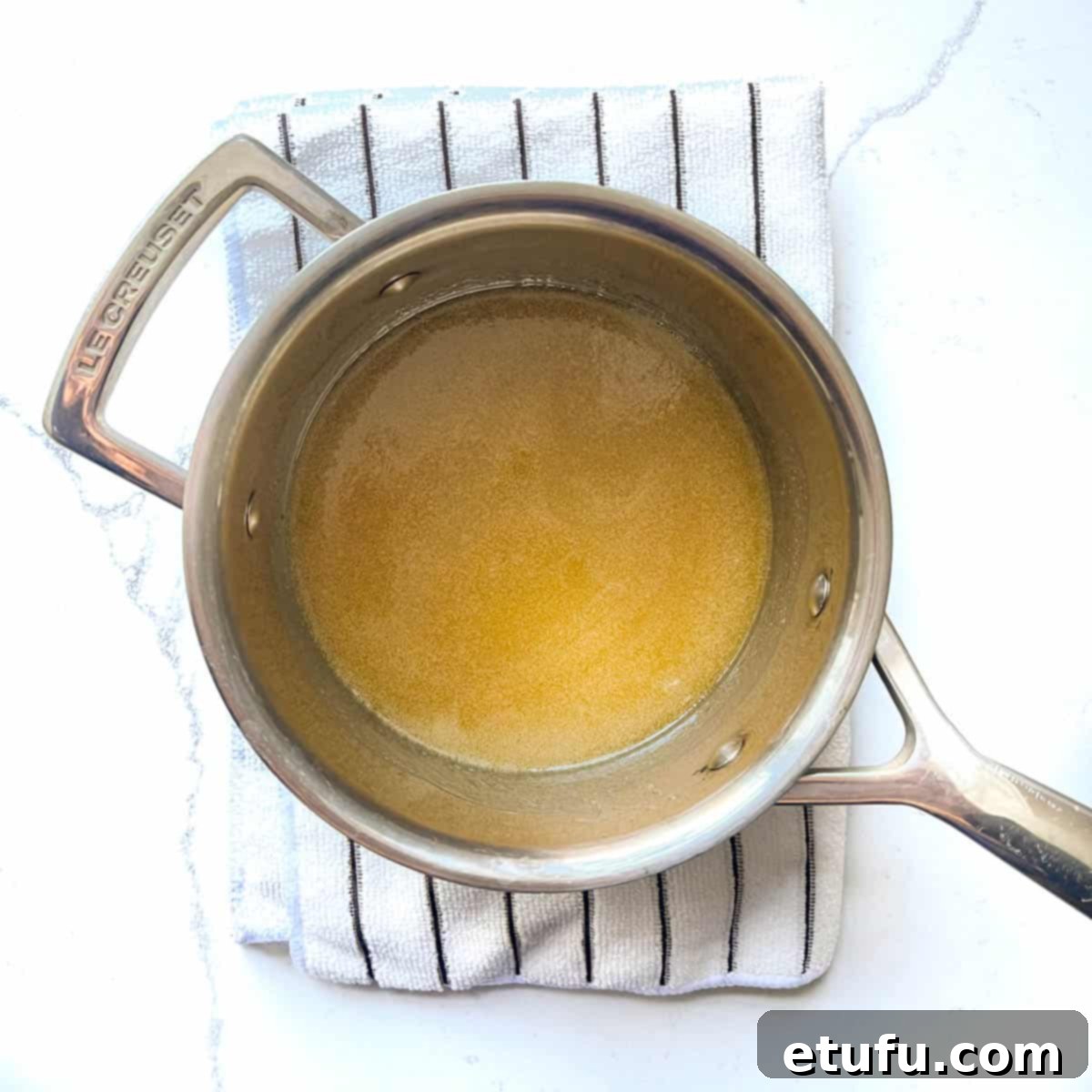
- Activate Bicarbonate of Soda: Measure the boiling water into a small, separate bowl. Add the bicarbonate of soda and give it a quick stir. You’ll notice it start to fizz slightly. Immediately pour this activated bicarb mixture into the melted butter mixture in the saucepan. It will foam up a little; this reaction helps give the biscuits a lovely texture.
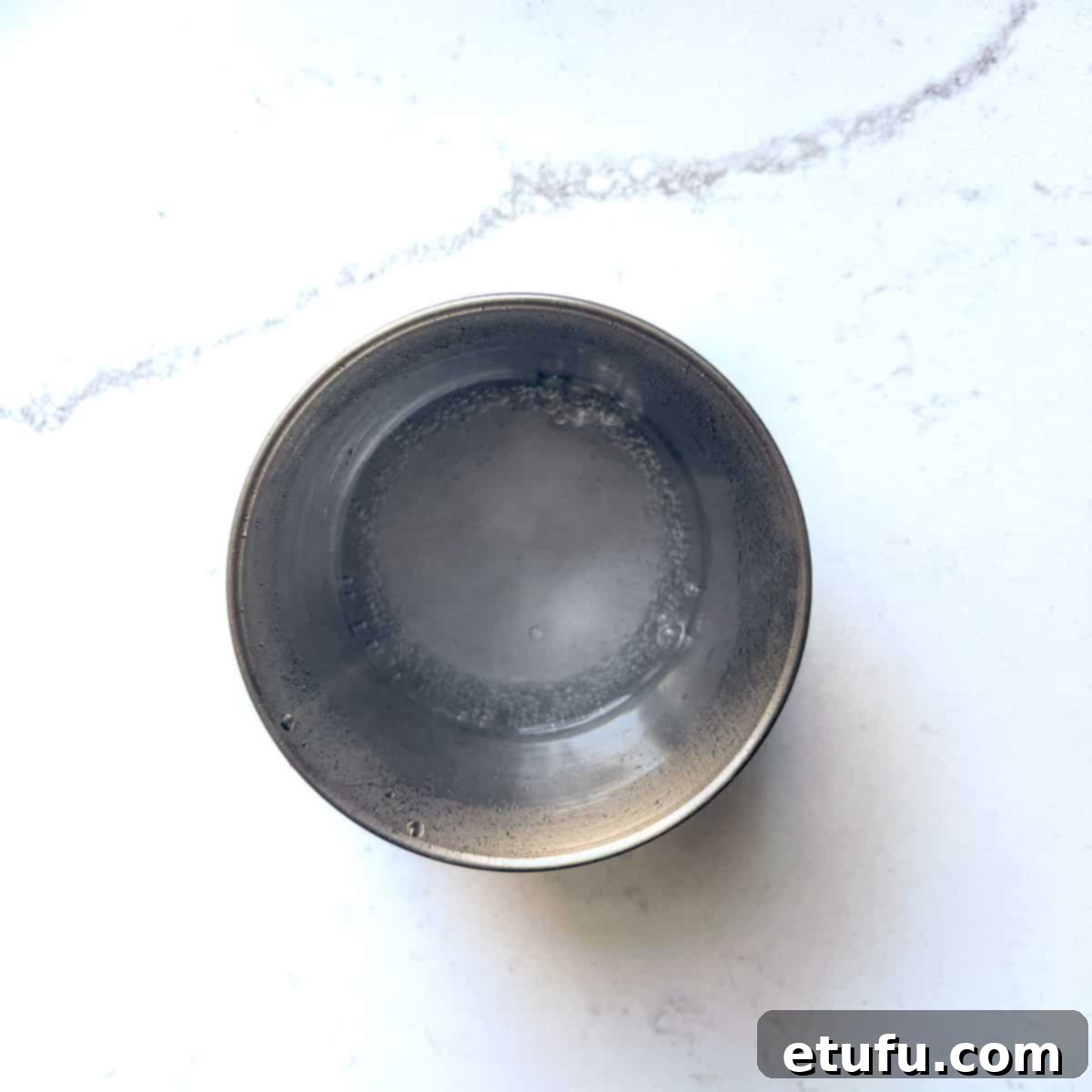
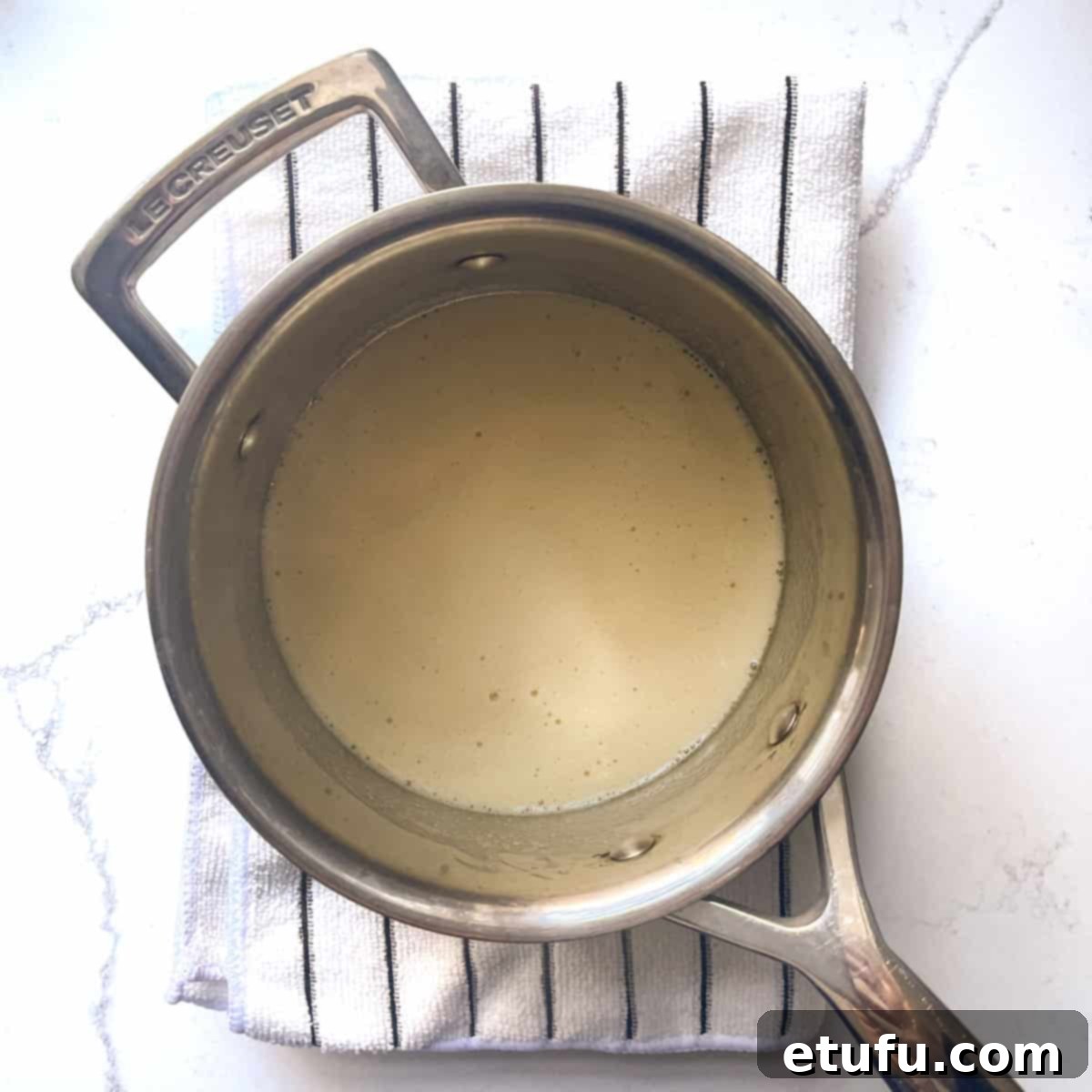
- Combine Wet and Dry: Create a small well in the center of your dry ingredients in the large mixing bowl. Pour the warm butter mixture into this well. Using a large spoon, gently combine everything until a cohesive dough forms. Ensure you scrape the bottom and sides of the bowl to incorporate all the dry ingredients, leaving no powdery bits behind.

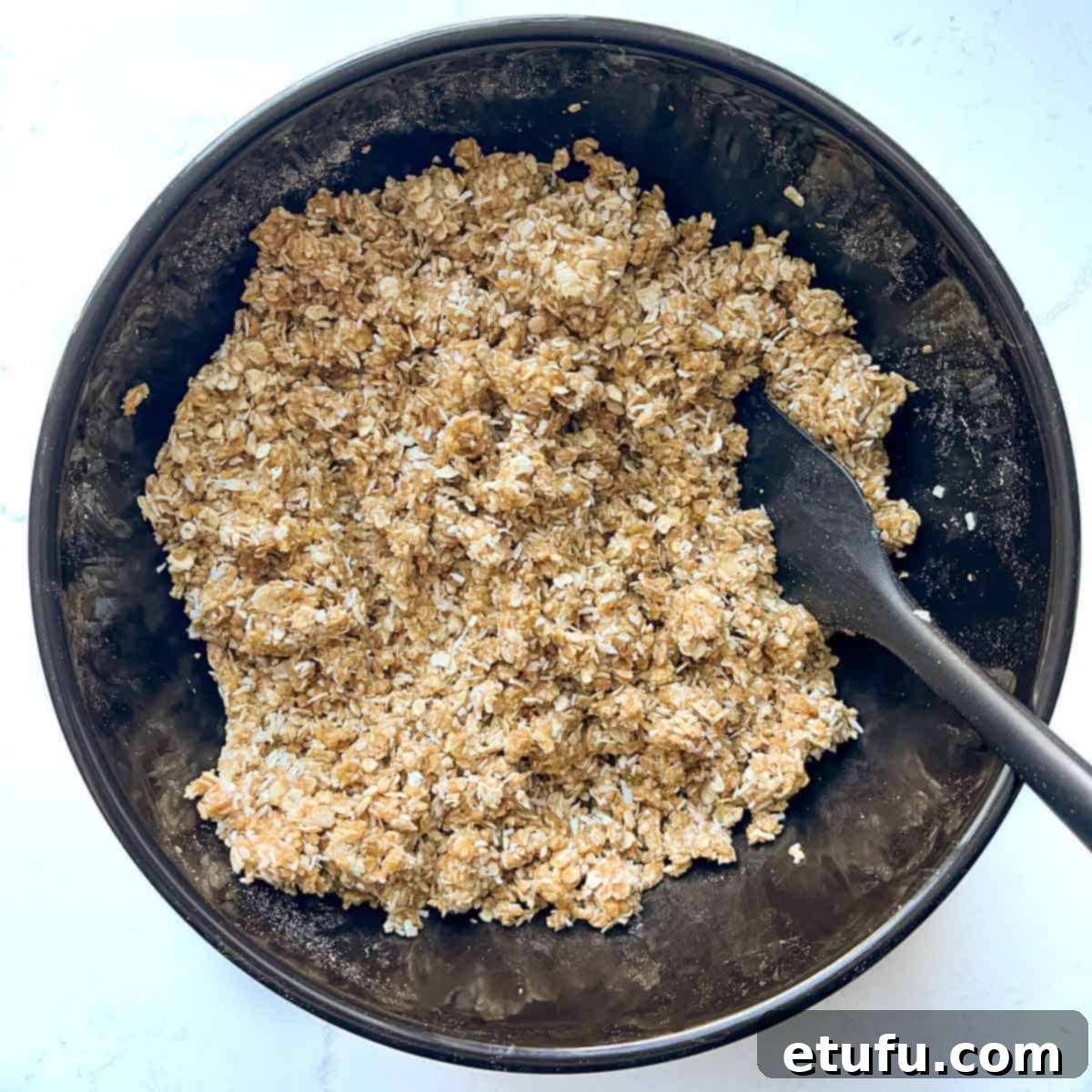
- Shape the Biscuits: With clean hands, take generous pieces of the cookie dough and roll them into neat balls. For consistent sizing, we recommend weighing each dough ball to approximately 50g, which should yield around 16 perfectly sized biscuits. However, if you prefer a more rustic look, eyeballing the size is perfectly fine.
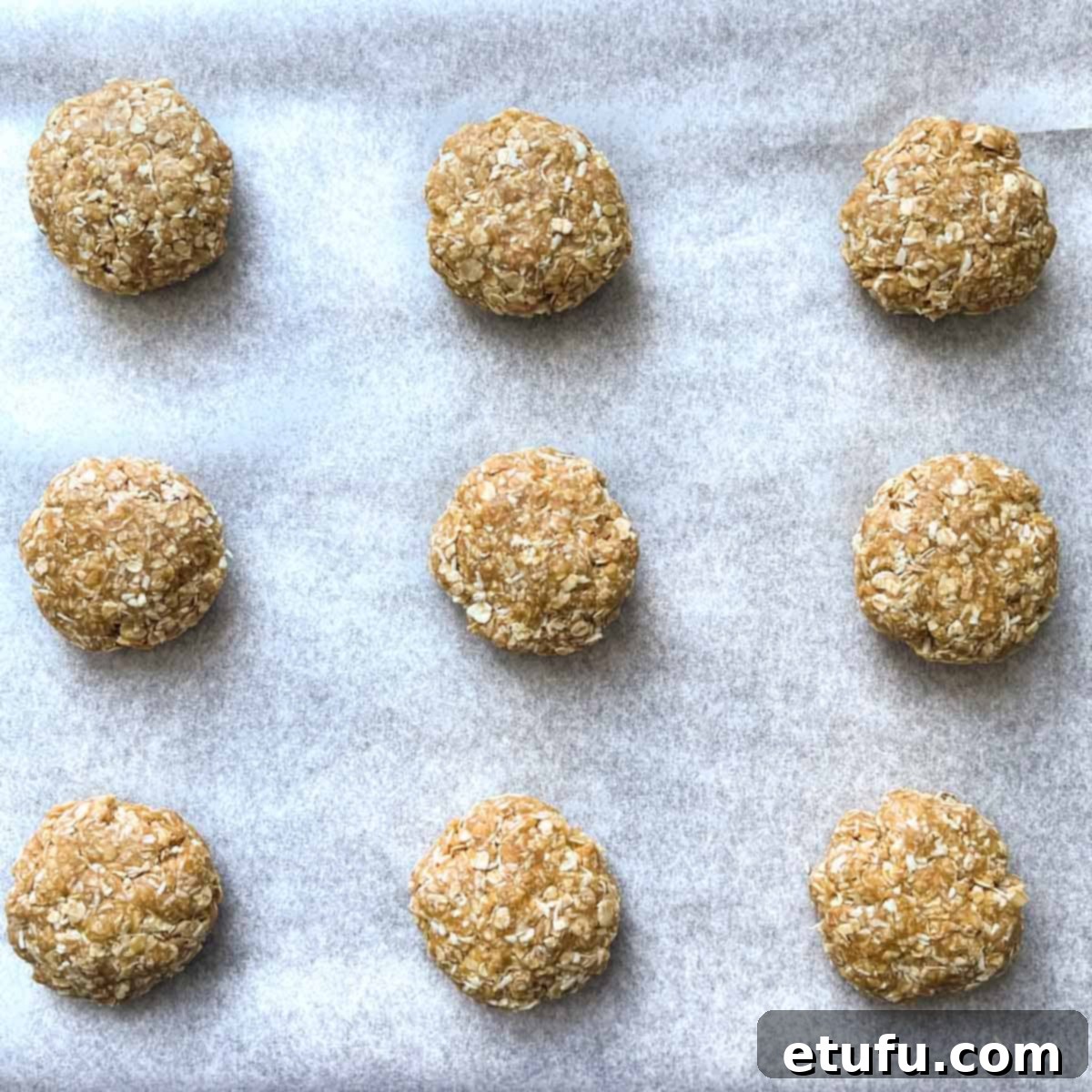
- Flatten and Prepare for Baking: Place the dough balls onto the prepared baking trays. Using the palm of your hand, gently press down on each ball until it’s about 1cm (0.4″) thick. Due to the high oat content, this is a coarse and thick dough. If you notice any cracks forming on the sides as you flatten them, simply pinch them closed to keep the biscuits intact.
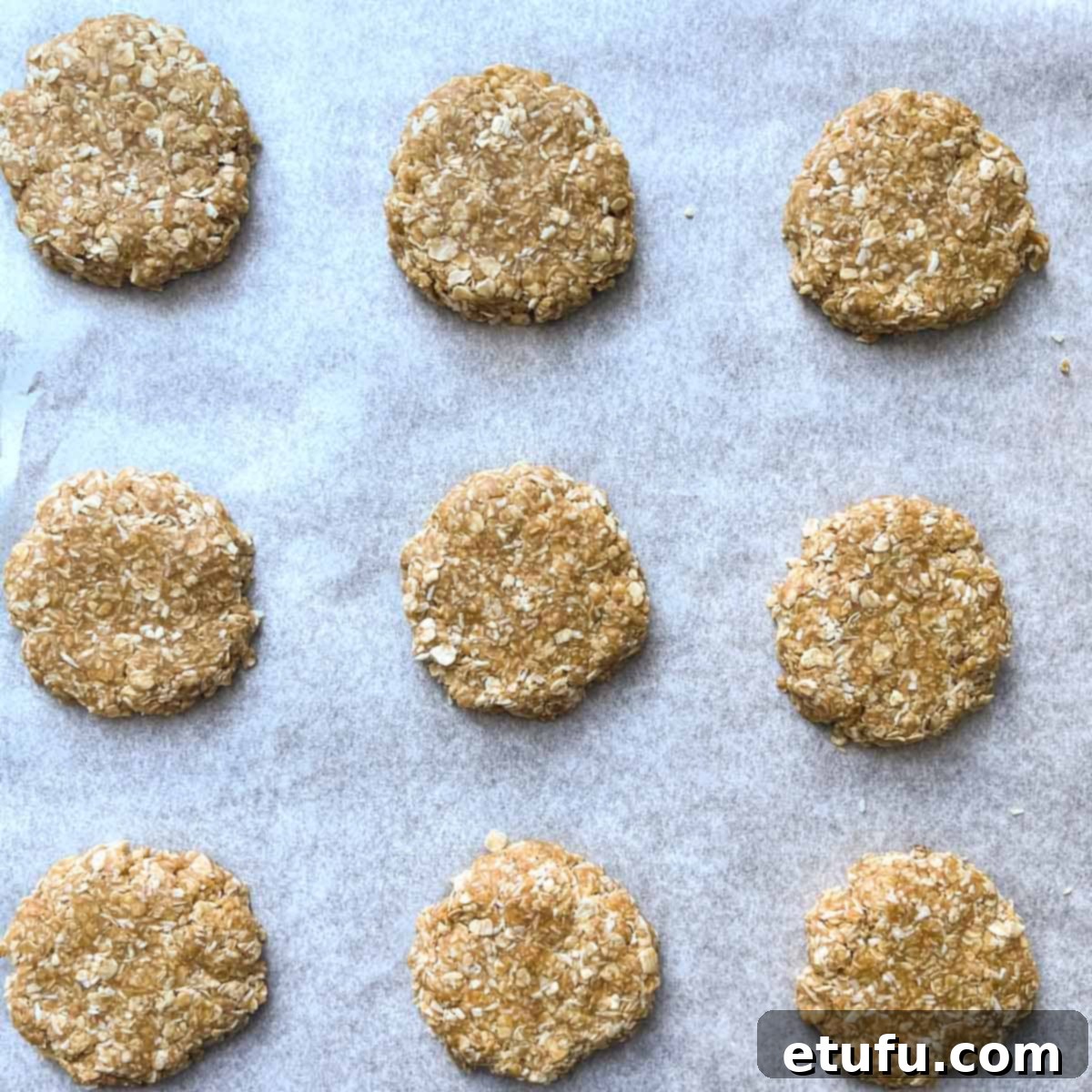
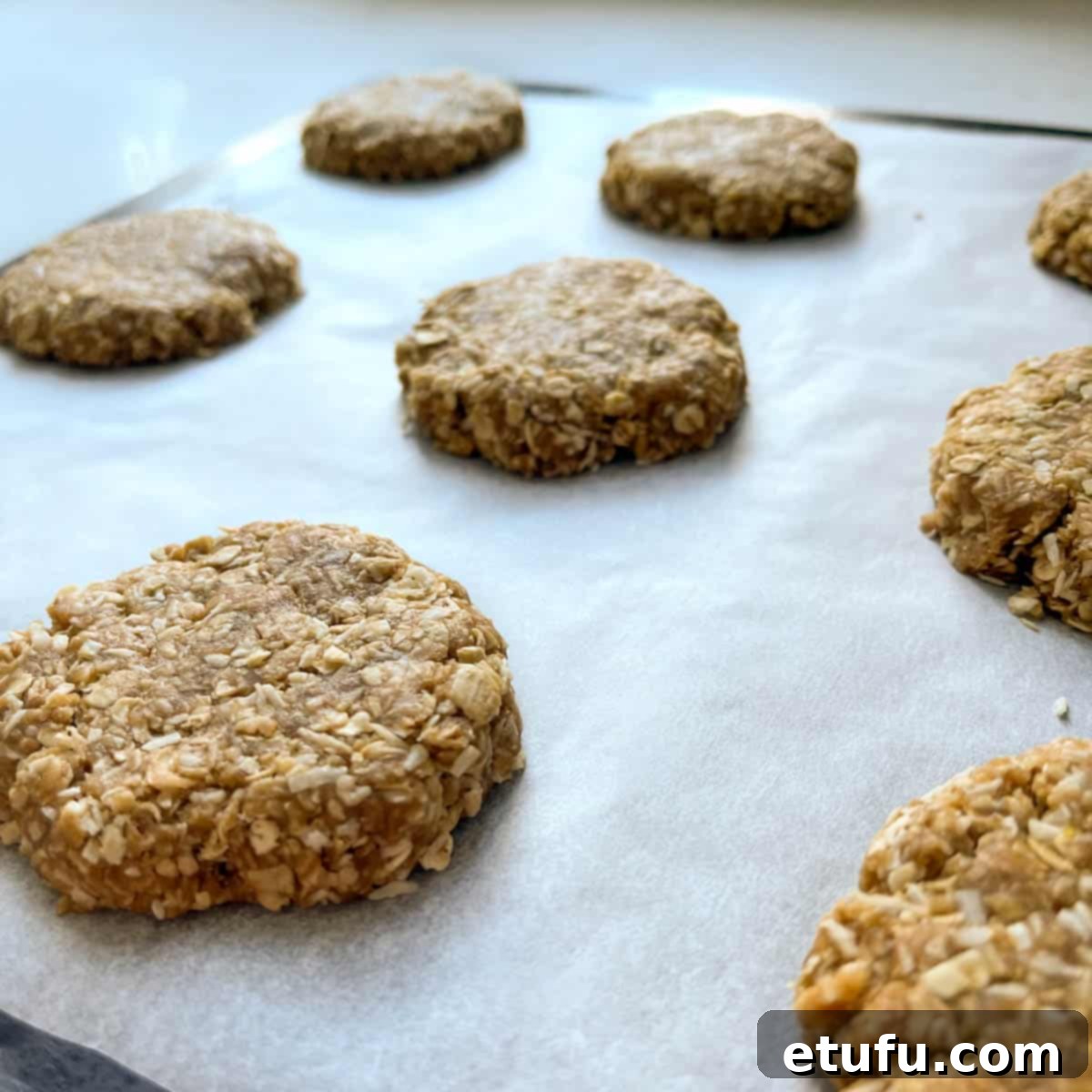
Space the biscuits approximately 5cm (2″) apart on the baking sheet. These biscuits don’t spread significantly during baking, so the shape you create now is largely how they will look when they emerge from the oven.
- Bake to Golden Perfection: Bake in the preheated oven for 14-15 minutes. Keep an eye on them; they are ready when the tops turn a beautiful light golden brown and the edges are firm.
- Cooling: Once baked, remove the trays from the oven. Allow the biscuits to cool completely on their baking trays for 5-10 minutes. This resting period is crucial, as it allows them to firm up before being carefully transferred to a wire cooling rack to cool completely.
Tips for Perfect Syrupy Coconut Biscuits
Achieving bakery-quality results at home is easier than you think with these simple tips:
- Don’t Overmix: Once the wet and dry ingredients are combined, mix just until a dough forms. Overmixing can develop the gluten in the flour, leading to tougher biscuits rather than beautifully chewy ones.
- Gentle Heat for Melting: When melting the butter and golden syrup, use a gentle heat. This prevents the mixture from scorching and ensures the golden syrup retains its delightful consistency and flavor.
- Watch Your Oven: Every oven is a little different. Keep an eye on your biscuits during the last few minutes of baking. They should be golden brown around the edges and slightly softer in the center, firming up as they cool. Overbaking can lead to dry, crumbly biscuits.
- Cooling is Key: Resist the temptation to move them too soon! Allowing the biscuits to cool on the baking sheet for several minutes is essential. They are delicate when hot and need this time to set and firm up before being moved to a cooling rack.
- Measure Precisely (Especially Syrup): For best results, use a kitchen scale to measure ingredients, particularly the golden syrup. It’s much easier and more accurate than trying to measure sticky syrup with spoons.
Decoration and Customization Ideas for Your Coconut Biscuits
While these rich butter coconut biscuits are absolutely delicious plain, their versatility means you can easily dress them up to suit any occasion or preference:
- Chocolate Drizzle: For a touch of indulgence, melt your favorite chocolate (dark, milk, or white) and drizzle it artfully over the cooled biscuits.
- Half-Dipped Elegance: Dip half of each cooled cookie into melted chocolate for a more pronounced chocolatey experience and a sophisticated look.
- Toasted Coconut Sprinkle: For an extra layer of coconut flavor and crunch, sprinkle toasted desiccated coconut over the still-warm biscuits or over the freshly applied chocolate drizzle.
Variations on this Coconut Biscuit Recipe
Get creative and make these biscuits uniquely yours with these delightful twists:
- Flavor Extracts: Swap the vanilla extract for a different essence. Caramel extract enhances the syrupy notes, while almond extract adds a sophisticated, nutty undertone.
- Chocolate Chip Delight: Fold in a handful of chocolate chips (milk, dark, or white) into the dough for bursts of melty chocolate goodness.
- Nutty Crunch: Introduce a lovely texture and depth of flavor by mixing in chopped nuts like almonds, pecans, or walnuts.
- Tropical Medley: For an exotic flair, incorporate diced dried fruits such as pineapple, mango, or papaya.
- Warm Cinnamon Spice: A sprinkle of ground cinnamon in the dough adds a comforting warmth, perfect for cooler days.
- Zesty Lemon Burst: A pinch of lemon zest brightens the entire biscuit with a refreshing citrusy note.
- Berry Bliss: Dried cranberries, blueberries, or raspberries folded into the dough add a delightful tartness and vibrant color.
- Almonds & Chocolate Combo: Combine the best of both worlds by mixing in chopped almonds and mini chocolate chips.
- Peanut Butter Kick: Swirl a dollop of creamy or crunchy peanut butter into the dough for a rich, nutty, and satisfying twist.
- Spiced Pumpkin (Seasonal): For an autumnal treat, add a tablespoon of pumpkin puree and a dash of pumpkin spice mix to the dough.
- Subtle Matcha: A teaspoon of matcha powder can infuse the biscuits with an earthy, slightly bitter green tea flavor, offering a unique profile.
- Orange Zest Zing: Grated orange zest provides a lovely, aromatic citrusy dimension that pairs beautifully with coconut.
- Chai Spice Blend: Incorporate a chai spice mix (featuring cinnamon, cardamom, ginger, and cloves) for a warm and aromatic biscuit.
- Extra Toasted Coconut: Lightly toast some shredded coconut in a dry pan until golden brown before folding it into the dough. This amplifies the nutty flavor and adds an extra layer of crispy texture.
- Maple Pecan: Mix in chopped pecans and a drizzle of maple syrup directly into the dough for a classic, comforting flavor combination.
- Gingerbread Warmth: Blend gingerbread spice mixes, including ginger, cinnamon, nutmeg, and cloves, into the dough for a festive, spiced biscuit.
The Biscuit Sizes: Crafting Your Perfect Cookie
For consistent baking and presentation, we prefer to weigh each dough ball. A 50-gram dough ball yields a perfectly sized, standard biscuit, resulting in approximately 16 cookies from this recipe. This method ensures even baking and a uniform batch.
However, if you’re in the mood for a truly indulgent, colossal treat, feel free to double the weight to a generous 100 grams per cookie! Just be prepared – one of these giant biscuits might just keep you happily satisfied for the rest of the day. Enjoy them responsibly!
If precision isn’t your priority, simply use your intuition to shape the dough into balls of your desired size. The beauty of homemade baking is that every cookie, regardless of its exact dimensions, is made with love.
Storage and Freezing: Keeping Your Coconut Biscuits Fresh
Storage
These resilient coconut biscuits boast an impressive shelf life. Once completely cooled, store them in an airtight container at room temperature. They will remain wonderfully fresh and chewy for up to three weeks, making them perfect for meal prepping snacks or having on hand for unexpected guests.
Freezing Baked Coconut Biscuits
Yes, you can absolutely freeze these **oat coconut cookies**! They are an excellent candidate for batch baking. Allow the baked biscuits to cool completely, then arrange them in a single layer on a baking sheet and flash freeze for about an hour until solid. Transfer the frozen biscuits to a freezer-safe bag or airtight container, separated by parchment paper, and store them for up to 6 months. Thaw at room temperature or gently warm in the oven for a freshly baked taste.
Freezing Unbaked Dough
For ultimate convenience, you can also freeze the raw cookie dough before baking. Shape the dough into balls, then wrap them thoroughly in plastic wrap, followed by a layer of aluminum foil, before placing them in a freezer-safe bag or container. Store in the freezer for up to 3 months. To defrost, transfer the frozen dough balls to the fridge overnight. The next day, roll into balls if needed, flatten, and bake according to the recipe instructions, adding a minute or two to the baking time if they are still very cold.
Frequently Asked Questions About Coconut Biscuits
What is the difference between a “biscuit” and a “cookie” in this context?
In British English, “biscuit” refers to what Americans would call a “cookie” – a sweet, often flat, baked good. In American English, a “biscuit” is typically a savory, scone-like quick bread. This recipe uses the British definition, so these are indeed sweet, chewy treats that would be called cookies in the US.
Can I use quick oats instead of rolled oats?
While rolled oats are preferred for their texture and chewiness, quick oats can be used. However, they are more finely cut and will absorb liquids faster, potentially resulting in a softer, less chewy biscuit. Adjusting the liquid slightly or letting the dough rest briefly before shaping might be necessary.
What can I use if I don’t have golden syrup?
Golden syrup offers a unique flavor and texture, but if you can’t find it, you have a few alternatives:
- Light Corn Syrup: This is the closest in terms of consistency and will yield a similar chewiness, though it lacks the distinct caramel notes of golden syrup.
- Maple Syrup or Honey: These can be used, but be aware they will impart their own distinct flavors to the biscuits, changing the profile. They might also be slightly thinner, so the dough could be a bit stickier.
Are these coconut biscuits gluten-free?
As written, this recipe uses all-purpose flour, so it is not gluten-free. To make them gluten-free, you would need to substitute the all-purpose flour with a gluten-free flour blend and ensure your oats are certified gluten-free (as oats can sometimes be cross-contaminated during processing).
Can I make these biscuits vegan?
Yes, with a couple of substitutions! Replace the unsalted butter with a good quality plant-based butter alternative. Most golden syrup brands are naturally vegan, but always check the label to ensure it doesn’t contain any animal-derived ingredients.
More Coconut-Inspired Recipes You Can Try
If you love the tropical flavor of coconut, you might also enjoy these other delightful recipes:
A Syrupy, Sweet, and Moist Coconut Tart
Tropical Coconut Rice
Refreshing Coconut Yogurt Milkshake
Festive Coconut Date Balls with Christmas Flavors
Rich Coconut Milk Beef Curry
Easy Peasy Coconut Ice
Other Easy Cookie Recipes You Might Enjoy
- Chocolate Chip Coffee Cookies
- Cheerful Smartie Cookies
- Chocolate Chip Cookies without Brown Sugar
- Outydse Soetkoekies – South African Spice Biscuits
Recipe Card: Easy Chewy Coconut Biscuits
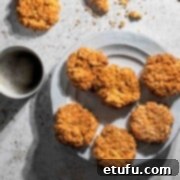
Easy Chewy Coconut Biscuits
These incredibly easy coconut biscuits are delightfully syrupy and wonderfully chewy, a world apart from light macaroons. Packed with wholesome oats, rich desiccated coconut, dark brown sugar, and golden syrup, they are substantial and satisfying. Think of them as the perfect blend of an Aussie Anzac cookie and a British flapjack, ready in no time with just a few basic ingredients. They make a fantastic companion for a cup of tea or a hearty snack on the go.
Save Recipe
Course: Dessert, Snack
Cuisine: International
Prep Time: 10 minutes
Cook Time: 15 minutes
Total Time: 25 minutes
Servings: 16 cookies
Calories: 213 kcal
Author: Maretha Corbett
Ingredients
- 225 grams rolled oats (oatmeal)
- 150 grams all-purpose flour
- 150 grams dark brown sugar
- 140 grams desiccated coconut
- 150 grams unsalted butter
- 4 tablespoons golden syrup (approx. 80g)
- 2 teaspoons vanilla extract
- 1 teaspoon bicarbonate of soda
- 3 tablespoons boiling water
Instructions
- Preheat your oven to 170℃ (338℉ / Gas Mark 3). Line two baking sheets with parchment paper.
- In a large mixing bowl, combine the rolled oats, all-purpose flour, dark brown sugar, and desiccated coconut. Ensure you break apart any lumps in the dark brown sugar. Set aside.
- In a small saucepan, add the unsalted butter, golden syrup, and vanilla extract. Melt these ingredients together over a gentle heat until smooth.
- Measure the boiling water into a small bowl and add the bicarbonate of soda, stirring quickly. Immediately pour this mixture into the melted butter mixture in the saucepan. It will foam slightly.
- Make a well in the center of your dry ingredients. Pour the warm butter mixture into the well and combine everything with a large spoon, ensuring all dry ingredients from the bottom of the bowl are incorporated into the dough.
- Using your hands, take large pieces of the cookie dough and roll them into balls. For consistent sizing, aim for about 50 grams per ball, yielding approximately 16 biscuits.
- Place the dough balls on the prepared baking sheets. With the palm of your hand, gently press down on each ball until it is about 1cm (0.4″) thick. If cracks appear on the sides due to the coarse nature of the oat dough, simply pinch them shut.
- Space the biscuits approximately 5cm (2″) apart on the baking sheets. They will not spread significantly during baking, so their initial shape is key.
- Bake for 14-15 minutes in the preheated oven, or until the biscuits are lightly golden brown on top and firm at the edges.
- Allow the baked biscuits to cool on their baking trays for 5-10 minutes before carefully transferring them to a wire cooling rack to cool completely.
Nutritional Data Disclaimer
Please note that the nutritional information provided is an estimate calculated by a third party, and we cannot guarantee its absolute accuracy. We strive to offer the most precise information possible, but we are not responsible for any potential errors. The nutritional value of this recipe may vary depending on the exact brands and products used. We recommend consulting with a qualified healthcare professional or a registered dietitian for personalized advice regarding your dietary needs.
Nutrition Facts (per serving)
Calories: 213 kcal | Carbohydrates: 27g | Protein: 4g | Fat: 11g | Saturated Fat: 6g | Polyunsaturated Fat: 1g | Monounsaturated Fat: 3g | Sodium: 78mg | Potassium: 133mg | Fiber: 2g | Sugar: 15g | Vitamin C: 0.1mg | Calcium: 17mg | Iron: 1mg
For food safety advice, including guidance on food allergies, please refer to official food safety authorities.
